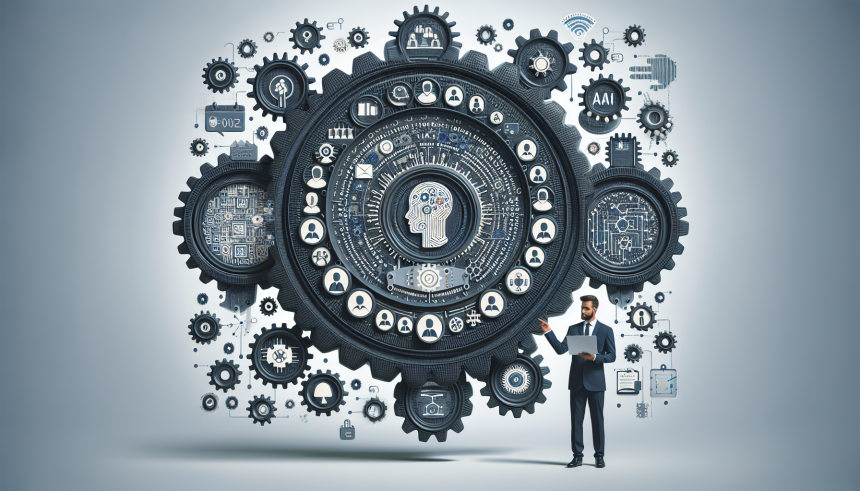Automating HR Processes: AI Tools for Recruitment and Onboarding
1. Understanding the Importance of HR Automation
In today’s fast-paced business environment, human resource departments are faced with the challenge of managing a growing number of tasks efficiently. Automating HR processes through AI tools not only enhances efficiency but also significantly improves employee experience. By leveraging technology, organizations can reduce time-consuming manual processes and allow HR professionals to focus on strategic initiatives that nurture talent and drive performance.
2. The Role of AI in Recruitment
2.1 Streamlining Candidate Sourcing
AI tools can sift through vast amounts of data far more efficiently than traditional methods. Using natural language processing (NLP) and machine learning algorithms, these tools can crawl through job boards, social media, and professional networks to identify potential candidates who match specific criteria. Platforms like HireVue use AI to analyze resumes and suggest qualified candidates, minimizing the time spent on initial sourcing.
2.2 Enhancing Candidate Screening
Screening candidates can often feel like finding a needle in a haystack. AI recruitment tools, such as Pymetrics and X0PA AI, utilize predictive analytics and automated assessments to evaluate candidates beyond their resumes. They analyze behavioral traits, cognitive skills, and cultural fit, providing HR professionals with insights that help in selecting the right candidates for interviews.
3. Recruitment Marketing
3.1 Personalized Job Advertising
AI-driven marketing platforms can personalize job advertisements based on candidate data. Tools like Jobvite utilize algorithms that suggest jobs to potential candidates by analyzing their online behavior and preferences. By delivering personalized job recommendations, organizations can increase engagement rates, attracting higher-quality applicants.
3.2 Employer Branding
With innovative AI-powered tools, organizations can manage their employer branding more effectively. Platforms like Glassdoor and LinkedIn Talent Insights allow HR teams to analyze competitor trends and gauge employee sentiment. AI tools can also optimize social media campaigns, ensuring that the company’s values and culture attract the right talent, thereby enhancing the employer brand.
4. Interviewing Process Automation
4.1 AI-Powered Chatbots
AI chatbots, such as those provided by Mya Systems or WoBot, can handle initial candidate interactions. These bots engage candidates through conversational interfaces, scheduling interviews, answering FAQs, and providing information about the company. This not only enhances the candidate experience but also frees up recruiters’ time for more strategic tasks.
4.2 Video Interviewing with AI Analytics
Video interviewing has gained traction, especially in remote recruitment scenarios. Platforms like Hiretual use AI to analyze candidate responses during interviews, assessing their fit based on verbal and non-verbal cues. This data-driven approach helps HR professionals make informed decisions while minimizing biases associated with traditional interviewing.
5. Onboarding Automation
5.1 Streamlined Document Management
The onboarding process often involves an avalanche of paperwork. AI-driven tools such as BambooHR facilitate seamless document management by automating the distribution and secure collection of onboarding materials. This helps ensure compliance while also offering a superior onboarding experience for new hires.
5.2 Personalized Onboarding Experience
With AI tools, companies can create customized onboarding plans based on the specific needs of new hires. Platforms such as Gusto offer tailored onboarding workflows that align with individual roles, allowing new employees to engage with relevant training materials and company resources right from their first day on the job.
6. Data-Driven Decision Making
6.1 Enhanced Reporting and Analytics
AI tools provide HR teams with robust analytics capabilities. Platforms like Greenhouse and Workable offer real-time reporting features that allow HR professionals to track the effectiveness of recruitment strategies, onboarding processes, and employee retention metrics. With predictive analytics, organizations can foresee hiring needs and make data-driven decisions to optimize their workforce.
6.2 Continuous Feedback Mechanisms
AI-driven feedback tools, such as Culture Amp, facilitate ongoing employee engagement and feedback collection post-onboarding. This ensures that new hires feel supported and connected, which is crucial for retention. Such continuous data collection feeds back into the recruitment process, allowing for ongoing refinement and improvement.
7. Challenges of AI in HR
7.1 Over-Reliance on Algorithms
While AI tools are powerful, there is a risk of over-reliance on algorithms that may inadvertently reinforce bias, especially if the data used is not representative. HR professionals must balance the efficiency of AI with human judgment to avoid potential pitfalls.
7.2 Data Privacy Concerns
As HR departments adopt AI tools, they must remain vigilant about data privacy. Compliance with regulations such as GDPR is crucial. Organizations should ensure that any AI tool in use has robust data protection measures in place to safeguard sensitive employee information.
8. Best Practices for Implementing AI Tools in HR
8.1 Define Clear Objectives
Before implementing AI tools for recruitment and onboarding, organizations should define specific objectives. Whether it’s reducing time-to-hire or increasing employee retention, a clear goal helps in selecting the right tool to achieve measurable outcomes.
8.2 Pilot Programs
A phased approach to implementing AI tools through pilot programs allows organizations to assess their effectiveness and make necessary adjustments. Gathering feedback from HR staff and candidates during the pilot phase is essential for refining processes.
8.3 Training and Support
Successful implementation of AI tools depends on training and support for the HR team. Providing ongoing education about the technology’s capabilities ensures staff can leverage the tools to their fullest potential, promoting acceptance and proficiency.
8.4 Monitor and Evaluate
Using analytics to monitor the efficacy of AI tools is vital. Regularly evaluate key performance indicators (KPIs) related to recruitment and onboarding to identify areas for improvement and ensure alignment with overall HR strategies.
9. Future Trends in AI-Driven HR Automation
The landscape of HR automation is dynamic. Future trends may include increased integration of AI with other technologies such as augmented reality (AR) for onboarding, further enhancing the onboarding experience. Additionally, advancements in machine learning will likely lead to even more personalized candidate experiences, making recruitment and onboarding processes smoother and more efficient.
As organizations continue to embrace AI in HR, the focus will be on creating a collaborative ecosystem where technology complements human resources, fostering a more engaging and productive workplace.


